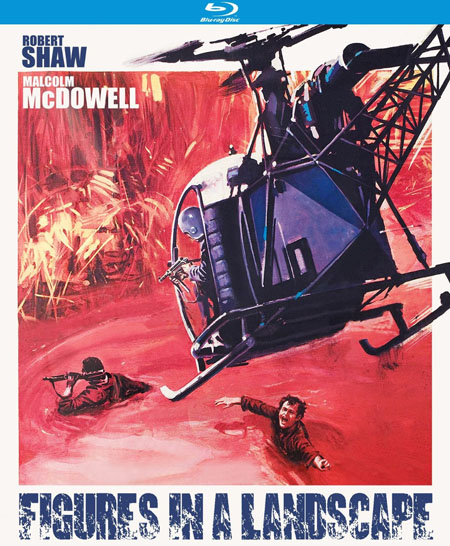
BY LEE PFEIFFER
I've long had admiration for the work of actor Robert Shaw ever since he impressed me at age 8 with his chilling interpretation of the SPECTRE psychotic killer Red Grant in "From Russia With Love". Shaw could always be counted on to deliver a fine performance even if the material he chose was sometimes underwhelming. Shaw was also a talented writer and playwright, having won acclaim for his play "The Man in the Glass Booth", which was inspired by the war criminal trial of Adolf Eichmann. Shaw, like many actors, participated in many questionable films in order to enable his real passion, which was to bring avante garde movie projects to fruition, even if they only appealed to the art cinema crowd. One of Shaw's most interesting vehicles is one of his least seen. "Figures in a Landscape" was his 1970 adaptation of an allegorical novel by Barry England that abounded with reference to the (then) on-going Vietnam war. Shaw dispensed with that aspect of the novel and instead played up its more opaque aspects, particularly those that concern the two protagonists in what is basically a two-character adventure. The film opens with Shaw and co-star Malcolm McDowell on the run in an unnamed country being pursued by unnamed forces (presumably the police and/or military) for unspecified crimes. One senses they are political prisoners in a totalitarian state but this is never addressed directly. Shaw is MacConnachie ("Mac"), a middle-aged man with a colorful past that often found him on the opposite side of the law. McDowell is Ansell, a twenty-something free spirited type from London whose social values are the polar opposite of Mac's old fashioned values. When we first see the men, they are running at a high rate of speed and have to contend with the major obstacle of having their hands bound behind their backs. We never learn how they effected their escape and from whom but these are just several key questions that Shaw's screenplay goes to lengths in terms of not filling in the audience on the details. The two men, bound by their mutual need for one another, bicker and bark at each other like Tony Curtis and Sidney Poitier in "The Defiant Ones" with Mac channeling his future performance as Quint in "Jaws" by constantly attacking the younger man for being the product of a soft generation. As these types of films generally play out, Mac and Ansell are able to win some small victories through mutual efforts and begin to develop a grudging but sincere admiration for each other. (In one of the script's few instances of humor, we learn that Mac is somewhat of a prude by the way he chastises the younger generation for the sexual promiscuity afforded by "The Pill".) They finally figure out a way to free their bonds and obtain food, water and arms. However, they find themselves relentlessly pursued by a helicopter piloted by faceless, nameless men who coordinate a widespread army of pursuers on the ground The image of the helicopter haunts Mac and Ansell throughout their desperate race across a harsh landscape that contains both deserts and high, snow-covered mountains. Throughout their ordeal, the men come to know each other better though Shaw's screenplay, perhaps not coincidentally, gives his character far meatier material than McDowell gets to work with. Shaw is at his best in the quiet sequences, reminiscing about his beloved wife who waits for his return home.

The film falls short of its Kafkaesque pretensions but is never less than engaging, thanks in no small part to the skill of director Joseph Losey in keeping the bizarre aspects of the scripts from becoming too alienating for the audience. There is also superb cinematography that does justice to the magnificent, if sometimes foreboding, Spanish landscapes and a fine score by the estimable Richard Rodney Bennett. It's unclear what Shaw was trying to say in this sometimes puzzling film that at times evokes aspects of Patrick McGoohan's classic TV series "The Prisoner". This jumbled aspect of the story robs the film of some of its potential dramatic payoffs but there is real satisfaction in watching Shaw and McDowell in parts that are this meaty. We only learn enough about each character to tantalize us even further regarding how they ended up in this dilemma and it's probably best that Shaw never provides any easy answers. However, some of the men's actions and interactions cry out for a bit more clarification especially in the exciting climax when Mac is motivated to take on downing the hated helicopter even at an unnecessary risk to his own life.
"Figures in a Landscape" has been released by Kino Lorber on Blu-ray. As with most of the company's titles, this one boasts a superb transfer that does justice to the impressive filming locations. Unfortunately, no extras are included. A pity because this film cries out for a commentary track that could have covered not only the movie itself but also Shaw's remarkable career, one that never completely fulfilled its potential because of his own personal demons.
CLICK HERE TO ORDER FROM AMAZON